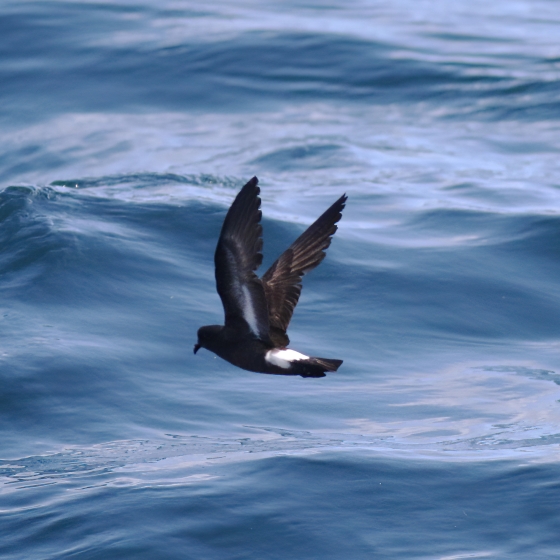Storm Petrel
Hydrobates pelagicus (Linnaeus, 1758)
TM
 STOPE
STOPE  520
520

Family: Procellariiformes > Hydrobatidae

This small petrel, not much larger than a House Martin and very similar in appearance, is extremely pelagic, spending most of its life at sea.
The Storm Petrel only comes to land during the summer months, making its breeding attempts on offshore islands and a few isolated headlands. Although it has an estimated breeding population in the UK of around 30,000 pairs, this is an extremely difficult species to see during the breeding season, only coming to land during the hours of darkness often staying at sea on bright moonlit nights.
Several Storm Petrel breeding colonies have been the subject of detailed study, with ringing data demonstrating that this is a long-lived bird, with some individuals living for over 30 years.
Identification
Storm Petrel identification is sometimes difficult. The following article may help when identifying Storm Petrel.
Identifying Petrels

Petrels are seldom-seen, unfamiliar birds to many of us, but both species: Storm Petrel and Leach's Petrel are actually very common breeding birds and frequently encountered off our shores during passage. Both are small black and white birds that seem to defy the rough seas they are often encountered in. How can we tell the two species apart?
SONGS AND CALLS
Listen to example recordings of the main vocalisations of Storm Petrel, provided by xeno-canto contributors.
Call
Song
Develop your bird ID skills with our training courses
Our interactive online courses are a great way to develop your bird identification skills, whether you're new to the hobby or a competent birder looking to hone your abilities.
Browse training coursesStatus and Trends
Population size and trends and patterns of distribution based on BTO surveys and atlases with data collected by BTO volunteers.
CONSERVATION STATUS
This species can be found on the following statutory and conservation listings and schedules.
POPULATION CHANGE
Storm Petrels are pelagic and nest underground, hence they are difficult to survey and the first reliable population estimates were made during the 1998–2002 Census (Seabird 2000) when tape-playback techniques were available to count occupied burrows. Until the results of the Seabirds Count (2015–2021) have been published the recent trend of the species is uncertain, although data available from some colonies suggest numbers have increased, including a doubling of the population at the largest colony on Mousa (JNCC 2022)
DISTRIBUTION
Storm Petrels breed on remote, small, rat-free, offshore islands on the Atlantic fringe of north and west Britain and Ireland from Shetland to Borhou in the Channel Islands. During the winter period of Bird Atlas 2007–11 they were recorded from 50 10-km squares, mostly along the North Sea coast and off southwest England.
Occupied 10-km squares in UK
| No. occupied in breeding season | 42 |
| % occupied in breeding season | 1.4 |
| No. occupied in winter | 46 |
| % occupied in winter | 1.5 |
European Distribution Map
DISTRIBUTION CHANGE
Change in occupied 10-km squares in the UK
| % change in range in breeding season (1968–72 to 2008–11) | -18.2% |
| % change in range in winter (1981–84 to 2007–11) | +162.5% |
SEASONALITY
Storm Petrel is a localised breeder present during the breeding season and recorded occasionally during autumn seawatching.

Movement
Information about movement and migration based on online bird portals (e.g. BirdTrack), Ringing schemes and tracking studies.
RINGING RECOVERIES
View a summary of recoveries in the Online Ringing Report.
Foreign locations of birds ringed or recovered in Britain & Ireland

Biology
Lifecycle and body size information about Storm Petrel, including statistics on nesting, eggs and lifespan based on BTO ringing and nest recording data.
SURVIVAL & LONGEVITY
View number ringed each year in the Online Ringing Report
Maximum Age from Ringing 
|
38 years 0 months 17 days (set in 2017) 
|
Typical Lifespan 
|
11 years with breeding typically at 4 year |
Adult Survival 
|
0.87  
|
BIOMETRICS
Wing Length 
|
Adults | 122.6±3 | Range 118–127mm, N=22122 |
| Juveniles | 123.1±3.1 | Range 119-127mm, N=22 | |
| Males | 121.8±2.4 | Range 117–126mm, N=126 | |
| Females | 122.4±2.5 | Range 118–126mm, N=391 |
Body Weight 
|
Adults | 25.6±4.9 | Range 22.5–29.1g, N=20482 |
| Juveniles | 24.8±2.6 | Range 20.8–29.4g, N=21 | |
| Males | 25.6±2.2 | Range 22.4–29.9g, N=109 | |
| Females | 27.1±2.7 | Range 23.2–32.0g, N=335 |
Feather measurements and photos on featherbase 
CODES & CLASSIFICATION
Ring size 
|
A2 (pulli B2 or A2) |
Field Codes 
|
2-letter: TM | 5-letter code: STOPE | Euring: 520 |
For information in another language (where available) click on a linked name
Research
Interpretation and scientific publications about Storm Petrel from BTO scientists.
CAUSES AND SOLUTIONS
Causes of change
The trend is uncertain and hence further research is needed to understand potential drivers of population change.
Links to more studies from ConservationEvidence.com
- Measuring nocturnal seabird activity and status using acoustic recording
- The status and distribution of European storm-petrels Hydrobates pelagicus and Manx shearwaters Puffinus puffinus on the Isles of Scilly
- Trials using shark liver oil to deter seabirds from eating bait during long-line fishing, Leigh, New Zealand
Read more studies about Storm Petrel on Conservation Evidence >
Would you like to search for another species?











Share this page